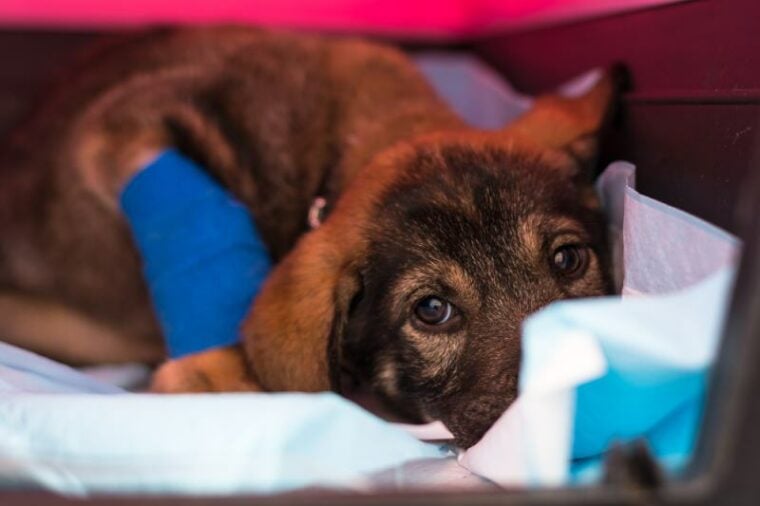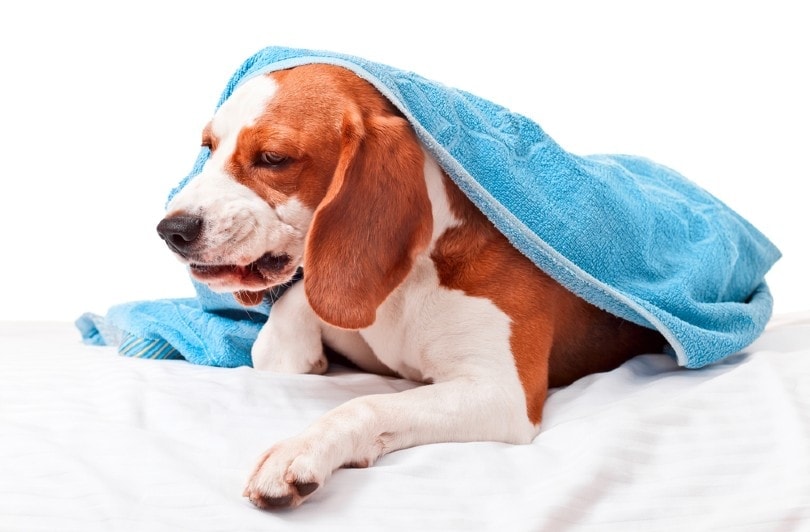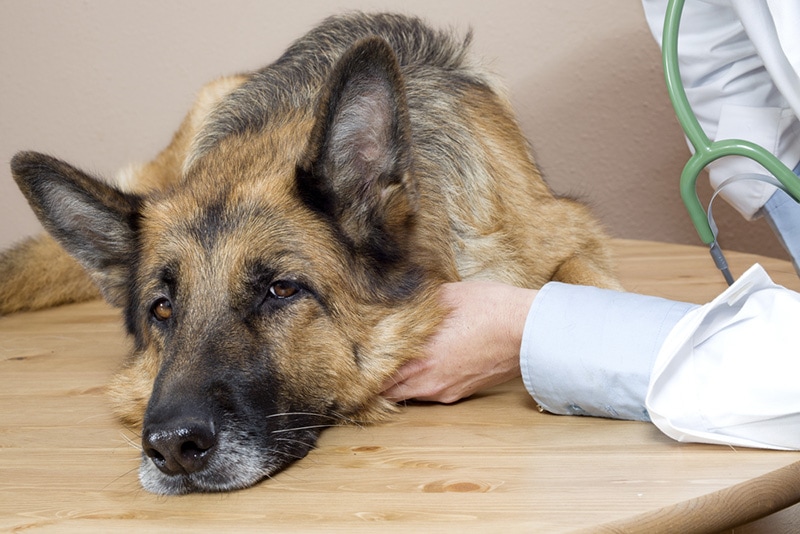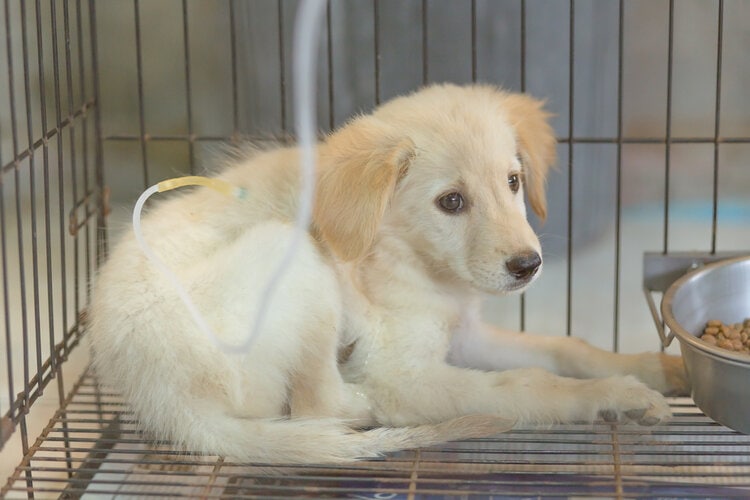
In Latin, ‘parvo’ means ‘small,’ so the literal translation of parvovirus is ‘a small virus.’ It is a strongly contagious and possibly even fatal disease, especially for puppies. For something that is apparently so minuscule, this little virus has certainly made itself known in the last 45 years. It has stomped its way through the dog population worldwide, causing an escalating illness that can be fatal without prompt treatment.
By the end of this article, you will have a good overview of parvovirus in dogs and be able to take one main point away: prevention is better than a cure!
What Is Parvovirus in Dogs?
In dogs, canine parvovirus (CPV) is a highly contagious and potentially fatal disease, particularly devastating for puppies and young dogs. It was first discovered in 1977, causing a worldwide epidemic of illness in our canine population. It is closely related to the feline panleukopenia virus (FPV), which made its debut fifty years before in cats.
However, since the 1970s, strides have been made in understanding canine parvovirus, and thankfully we have formulated an effective vaccination that provides protection against the virus. Despite this, it still circulates amongst our canine friends, and unfortunately, in areas where it is rampant, it will fill up isolation wards in veterinary hospitals, with the murmured words ‘parvo season’ provoking concerned shudders amongst staff.

What Are the Signs of Parvovirus?
The clinical signs of parvovirus include extreme lethargy and fatigue, abdominal pain, diarrhea, vomiting, loss of appetite, bloating, and fever. The diarrhea has a distinctive stomach-turning smell, often containing blood and mucus, and is very watery. Dogs go downhill rapidly and lose a lot of fluids through vomiting and diarrhea. They become dehydrated and, eventually, septic.
The fatality rate for untreated dogs exceeds 90%, and death can happen quickly, especially in young dogs from six weeks to six months old. However, a retrospective study that examined a decade of treatment of Canine Parvovirus in an animal shelter concluded that, with adequate treatment, survival rates exceed 86.6%.1
What Are the Causes of Parvovirus?
So, you can clearly see just how easy it would be for a dog to pick up an infection simply by coming into contact with infected feces, potentially deposited by a dog many months before. These feces containing the virus will have been stepped on and spread around the environment on the bottom of paws and shoes. In areas where the disease is rife, it doesn’t take much for an unvaccinated dog to encounter the pathogen.
However, not every dog who encounters parvovirus will become infected. It depends on their immune status at the time of exposure and the amount of virus they are exposed to. If they are infected, it takes three to seven days for signs of disease to show. In the meantime, the virus will have successfully wreaked havoc in the bone marrow and intestines of the dog, destroying many white blood cells that are responsible for an immune response in the body, enabling it to effectively target the cells that line the intestines. Once the intestinal lining is compromised, it loses its ability to absorb nutrients and allows bacteria to cross through the intestinal wall into the bloodstream.
In young dogs, the virus can also attack the heart cells, leading to inflammation of the heart muscle and potentially leading to acute heart failure and sudden death.

How Do I Care for a Dog With Parvovirus?
If your dog is exhibiting signs of the virus, it is essential to get them checked out by your veterinarian as soon as possible. Treatment has improved outcomes if established promptly, and patients require intense, supportive care to get through the illness.
Your vet will base their diagnosis on clinical signs, blood work, and a fecal test that can detect the virus in your dog’s stool. Treatment is dependent on how severe the dog is at the time of presentation; however, they will almost certainly require a hospital stay. They will be isolated from other animals to prevent transmission, which means the vets and nurses will wear full PPE (personal protective equipment) every time they enter the isolation ward and ensure that no objects that go into that room come back out again.
Dogs receive an intravenous fluid drip and replacement electrolytes if the bloodwork demonstrates any imbalances. If they have a very low white and red blood cell count from the destruction of cells in the bone marrow, they may require a blood transfusion or a transfusion of a component of blood called ‘plasma.’ This will help replace the blood cells that the virus has destroyed. They will be started on antibiotics to treat the secondary effects that the virus has on the body and will be given medication to ease the nausea and vomiting.
Most patients who get through the first three to four days of illness will make a full recovery. Treatment is time-consuming and expensive, and the old adage rings true: prevention is better than a cure!
Frequently Asked Questions (FAQs)
1. How Can I Prevent My Dog From Getting Parvovirus?
The yearly vaccination provides protection against canine parvovirus. Vaccination shouldn’t be considered optional, and especially for puppies, the timing of the boosters, as instructed by your vet, should be followed vigilantly.
For the first few weeks of a puppy’s life, the mother provides protection from disease through antibodies in her milk. These are thought to wane by 10–14 weeks of age, which means that the puppy’s immune system must take over. It is important that the puppy receives multiple doses of the vaccination over this time to protect against illness. You should also be extremely careful in allowing your puppy to socialize and go for walks whilst they are still vulnerable to infection.
2. My Dog Has Had Parvovirus Before. Can They Get It Again?
It is thought that if they have made a recovery from parvo, they are provided with immunity for some time, protecting them from reinfection. It’s not impossible, but it is very unlikely. It is still recommended that your dog has their vaccinations, regardless, as they need to be protected against the other diseases too.
3. Can Humans Catch Parvo?
Humans cannot catch parvovirus from dogs. It is species-specific and can’t jump from dog to human. Likewise, canine parvovirus cannot affect cats. They are affected by a different strain of the virus entirely.
4. How Long Does My Puppy Need to Be Isolated After Infection?
Dogs should be isolated during treatment and up to a fortnight post-recovery—ideally, three weeks.
5. How Do I Decontaminate My House After Infection?
Parvovirus, though tiny, is mighty! They are resistant to most household cleaning products but can be inactivated by bleach. You can use a dilute bleach solution (one part bleach to 30 parts water) on washable surfaces and objects, such as bowls and bedding. However, it is difficult to decontaminate your home completely and impossible to eliminate it from the outside environment. This is where vaccination takes precedence, and if you have any other dogs in your home, ensure that they are up to date with their boosters.

Conclusion
Parvovirus is a miserable illness for our canine population. However, we are fortunate to have an easily accessible vaccination for prevention. It is important to ensure that you follow veterinary instructions relating to puppy vaccinations and their exposure to the outside world. If you are worried that your dog may have parvovirus, even if they have had their vaccinations, it is best to contact your vet who can advise you further.
Featured Image Credit: Todorean-Gabriel, Shutterstock







